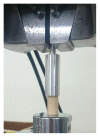Modification of Mechanical Properties, Polymerization Temperature, and Handling Time of Polymethylmethacrylate Cement for Enhancing Applicability in Vertebroplasty
- PMID: 27812530
- PMCID: PMC5080464
- DOI: 10.1155/2016/7901562
Modification of Mechanical Properties, Polymerization Temperature, and Handling Time of Polymethylmethacrylate Cement for Enhancing Applicability in Vertebroplasty
Abstract
Polymethylmethacrylate (PMMA) bone cement is a popular bone void filler for vertebroplasty. However, the use of PMMA has some drawbacks, including the material's excessive stiffness, exothermic polymerization, and short handling time. This study aimed to create an ideal modified bone cement to solve the above-mentioned problems. Modified bone cements were prepared by combining PMMA with three different volume fractions of castor oil (5%, 10%, and 15%). The peak polymerization temperatures, times to achieve the peak polymerization temperature, porosities, densities, modulus and maximum compression strengths of standard (without castor oil), and modified cements were investigated following storage at ambient temperature (22°C) or under precooling conditions (3°C). Six specimens were tested in each group of the aforementioned parameters. Increasing castor oil content and precooling treatment effectively decreased the peak polymerization temperatures and increased the duration to achieve the peak polymerization temperature (P < 0.05). Furthermore, the mechanical properties of the material, including density, modulus, and maximum compression strength, decreased with increasing castor oil content. However, preparation temperature (room temperature versus precooling) had no significant effect (P > 0.05) on these mechanical properties. In conclusion, the addition of castor oil to PMMA followed by precooling created an ideal modified bone cement with a low modulus, low polymerization temperature, and long handling time, enhancing its applicability and safety for vertebroplasty.
Figures








Similar articles
-
Low-modulus PMMA bone cement modified with castor oil.Biomed Mater Eng. 2011;21(5-6):323-32. doi: 10.3233/BME-2012-0679. Biomed Mater Eng. 2011. PMID: 22561251
-
Synthesis and characterization of a new vertebroplasty cement based on gold-containing PMMA microspheres.Biomaterials. 2016 Mar;82:60-70. doi: 10.1016/j.biomaterials.2015.12.024. Epub 2015 Dec 21. Biomaterials. 2016. PMID: 26751820
-
NMP-modified PMMA bone cement with adapted mechanical and hardening properties for the use in cancellous bone augmentation.J Biomed Mater Res B Appl Biomater. 2009 Aug;90(2):760-6. doi: 10.1002/jbm.b.31345. J Biomed Mater Res B Appl Biomater. 2009. PMID: 19280644
-
Chemical and physical properties of bone cement for vertebroplasty.Biomed J. 2013 Jul-Aug;36(4):162-7. doi: 10.4103/2319-4170.112750. Biomed J. 2013. PMID: 23989310 Review.
-
The chemistry of acrylic bone cements and implications for clinical use in image-guided therapy.J Vasc Interv Radiol. 2004 Feb;15(2 Pt 1):121-6. doi: 10.1097/01.rvi.0000109394.74740.56. J Vasc Interv Radiol. 2004. PMID: 14963178 Review.
Cited by
-
Precision medicine strategies for spinal degenerative diseases: Injectable biomaterials with in situ repair and regeneration.Mater Today Bio. 2022 Jun 23;16:100336. doi: 10.1016/j.mtbio.2022.100336. eCollection 2022 Dec. Mater Today Bio. 2022. PMID: 35799898 Free PMC article. Review.
-
Precooling storage of bone cement in percutaneous vertebroplasty for osteoporotic vertebral compression fracture.BMC Musculoskelet Disord. 2024 Dec 19;25(1):1032. doi: 10.1186/s12891-024-08162-x. BMC Musculoskelet Disord. 2024. PMID: 39702166 Free PMC article. Clinical Trial.
-
Identifying alternative antibiotics that elute from calcium sulfate beads for treatment of orthopedic infections.J Orthop Res. 2022 May;40(5):1143-1153. doi: 10.1002/jor.25135. Epub 2021 Jul 12. J Orthop Res. 2022. PMID: 34191350 Free PMC article.
-
Advances in materials used for minimally invasive treatment of vertebral compression fractures.Front Bioeng Biotechnol. 2023 Oct 25;11:1303678. doi: 10.3389/fbioe.2023.1303678. eCollection 2023. Front Bioeng Biotechnol. 2023. PMID: 37954022 Free PMC article. Review.
-
Optimizing bone cement stiffness for vertebroplasty through biomechanical effects analysis based on patient-specific three-dimensional finite element modeling.Med Biol Eng Comput. 2018 Nov;56(11):2137-2150. doi: 10.1007/s11517-018-1844-x. Epub 2018 May 28. Med Biol Eng Comput. 2018. PMID: 29806053
References
MeSH terms
Substances
LinkOut - more resources
Full Text Sources
Other Literature Sources

